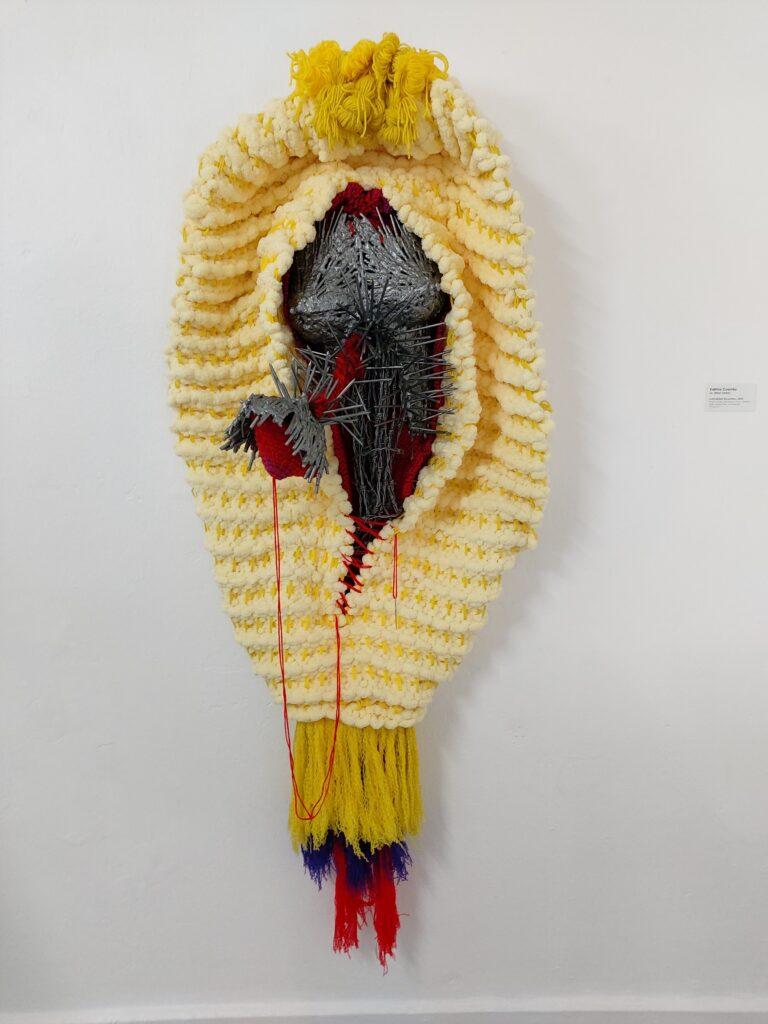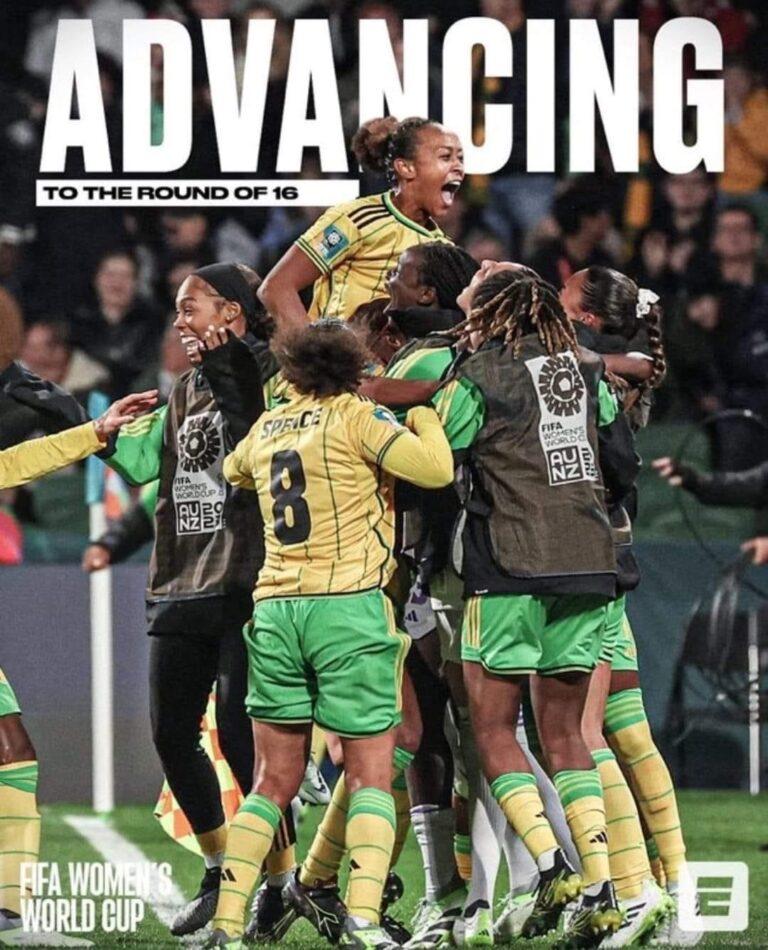“Fons et Origo”: The 2022 School Of Visual Arts final year exhibition – Part 2

It is one of the mantras of feminism that “the personal is the political”. This is something the current crop of graduating students at the Edna Manley College understands well. As we already saw in part 1 of this column, issues of identity and gender were important thematic concerns in the recent Fons et Origo final year exhibition and were pursued in ways which are, in various combinations, provocative, critical, and cathartic.
Tuesday Stewart, a photography student, explored the representation of the self in photography, not by concentrating on the face, as is traditionally done, but by shifting the focus to the body, exploring how personal identity is expressed in things such as posture and dress style, and how this is, in turn, moderated by the physical context. In a series of stark black-and-white self-portraits, Stewart photographed herself with her face covered in various types of patterned fabrics. While the first photographs in the series were done in the studio, the later ones, which were shown in Fons et Origo, were staged in a derelict building in downtown Kingston. The frontal poses used in the photographs added to the still, enigmatic monumental quality of the series and helped to generate multiple interpretative possibilities, some of which may have gone beyond the artist’s original intent. Representing the body, especially the black female body, is never an ideologically neutral act, but the covering of the face and the derelict setting added menacing allusions to violence and violation.
Much of the exhibition illustrated that traditional disciplinary boundaries and definitions matter less and less in contemporary art and while I have thus far focused on the Fine Arts Department, which is the part of the college’s programme with which I am most familiar, there were also contributions from the Applied Arts Department that reflected similar pursuits.
The illustrator Akeem Johnson’s Mandora project consisted of an outstanding series of posters and toy figurines, in which he reimagined figures from Jamaican performance and storytelling traditions, from Jonkonnu to Anancy, for the twenty-first century. Johnson’s fantastic and colourful characters, which draw from anime and other aspects of contemporary youth culture as well as his research on Jamaican folklore, provocatively challenge fixed gender identities and norms. Genderfluidity, while rarely acknowledged, has always had its place in Jamaica’s traditional culture. The politics of gender and its definitions have become an issue of significant discussion, positive and negative, in contemporary culture. This allows for an interesting and revealing dialogue between past and present, and the fictional and real in this project. Johnson’s work is smart, engaging, relevant to the present moment, and beautifully executed. He happens to be the younger brother of Leasho Johnson, who is already an acclaimed contemporary artist, and who also came out of the SVA visual communication programme.
The fashion designs by Stephen Burke took their inspiration from military and personal protection gear – two functional modes of dress that blur gender and identity lines. The uniform is usually associated with conformity and with asserting collective over individual identity but Burke rethinks and reimagines them into inventive sculptural, at times surrealist forms that allow for conformity to be challenged and individuality to take the upper hand, without however imposing gender norms. Avant-garde as they are, his designs are also quite wearable and, given the sort of adjustments that are in any case typically made between the conceptual imaginings of the haute couture runway and what is actually worn in daily life, his designs could easily be adapted into ready-to-wear fashion items. Given the right opportunities, Burke has the capacity to become one of the most original and innovative voices in Caribbean fashion design.
Those who visited this year’s SVA final year exhibition with the hope of discovering the latest art market darling may have been disappointed, although Akeem Johnson’s figurines were quickly scooped up by enthusiastic buyers, and Stephen Burke’s designs have obvious commercial potential. But, generally speaking, certainly in the Fine Arts Department we saw an implied rejection and pointed criticism of the hyper-capitalist, entrepreneurial orthodoxy that has overtaken much of the Jamaican art world, certainly when it comes to policy priorities and access funding opportunities. Even those young artists who produced work that could readily enter and thrive in the market foregrounded the function of art as an independent critical practice which engages with important social and cultural issues, rather than with the production of marketable commodities, “content” or urban beautification.
They do not stand alone in this: it is part of a broader stream in contemporary art, globally, which is pushing back against an increasingly out-of-control, hierarchical and materialistic art market and instead embraces an ethos of egalitarian collaboration and exchange, critical dialogue, and a commitment to social change. This new thrust is exemplified by the current Documenta in Kassel, which was curated by the Indonesian collective ruangrupa [sic], and while the event has had its own problems, it has provided major validation for the work of the non-profit art collectives that have popped up all over the globe, the Caribbean, notably, included. Two of the students in the Fons et Origo exhibition, Demar Brackenridge and Sheldon Green, have, in fact, been able to participate as artists-in-residence in Documenta as part of the Trinidadian art space Alice Yard’s presence there. They were accompanied by Camille Chedda, who lectures in the Fine Arts Department at the Edna Manley College and manages the Inpulse Art Programme here in Jamaica, of which Brackenridge and Green are both alumni. Inpulse has been funded by the Rubis Mécénat which illustrates that such approaches to art can, in fact, coexist with enlightened corporate funding.
But there is, indeed, a schism in the Jamaican art world that we need to acknowledge and understand. There are some in Jamaica who feel that it is the young artists who are on the wrong track, and that they and the programmes at the Edna Manley College need to be brought in line with the current entrepreneurial dictates and a more limited vision of what constitutes “Jamaican art” and “Brand Jamaica”. My position is that we need to listen to what these young artists are telling us, as this is important for the viability and balance of Jamaica’s art ecology, and Jamaican culture, generally, and there needs to be space and support for what they bring to the table. If not, we stand to lose an entire generation of artists who have unprecedented opportunities elsewhere or, alternatively, will turn away from art for other pursuits. The brain drain, which is such concern and topic for debate in Jamaica right now, indeed, also exists in the arts.
Dr Veerle Poupeye is an art historian specialized in art from the Caribbean. She lectures at the Edna Manley College of the Visual and Performing Arts in Kingston, Jamaica, and works as an independent curator, writer, researcher, and cultural consultant. Her personal blog can be found at veerlepoupeye.com.






